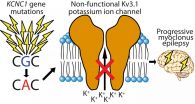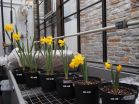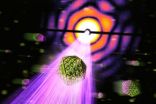(Press-News.org) Washington, D.C.--Silicon is the second most-abundant element in the earth's crust. When purified, it takes on a diamond structure, which is essential to modern electronic devices--carbon is to biology as silicon is to technology. A team of Carnegie scientists led by Timothy Strobel has synthesized an entirely new form of silicon, one that promises even greater future applications. Their work is published in Nature Materials.
Although silicon is incredibly common in today's technology, its so-called indirect band gap semiconducting properties prevent it from being considered for next-generation, high-efficiency applications such as light-emitting diodes, higher-performance transistors and certain photovoltaic devices.
Metallic substances conduct electrical current easily, whereas insulating (non-metallic) materials conduct no current at all. Semiconducting materials exhibit mid-range electrical conductivity. When semiconducting materials are subjected to an input of a specific energy, bound electrons can move to higher-energy, conducting states. The specific energy required to make this jump to the conducting state is defined as the "band gap." While direct band gap materials can effectively absorb and emit light, indirect band gap materials, like diamond-structured silicon, cannot.
In order for silicon to be more attractive for use in new technology, its indirect band gap needed to be altered. Strobel and his team--Carnegie's Duck Young Kim, Stevce Stefanoski and Oleksandr Kurakevych (now at Sorbonne) --were able to synthesize a new form of silicon with a quasi-direct band gap that falls within the desired range for solar absorption, something that has never before been achieved.
The silicon they created is a so-called allotrope, which means a different physical form of the same element, in the same way that diamonds and graphite are both forms of carbon. Unlike the conventional diamond structure, this new silicon allotrope consists of an interesting open framework, called a zeolite-type structure, which is comprised of channels with five-, six- and eight-membered silicon rings.
They created it using a novel high-pressure precursor process. First, a compound of silicon and sodium, Na4Si24, was formed under high-pressure conditions. Next, this compound was recovered to ambient pressure, and the sodium was completely removed by heating under vacuum. The resulting pure silicon allotrope, Si24, has the ideal band gap for solar energy conversion technology, and can absorb, and potentially emit, light far more effectively than conventional diamond-structured silicon. Si24 is stable at ambient pressure to at least 842 degrees Fahrenheit (450 degrees Celsius).
"High-pressure precursor synthesis represents an entirely new frontier in novel energy materials," remarked Strobel. "Using the unique tool of high pressure, we can access novel structures with real potential to solve standing materials challenges. Here we demonstrate previously unknown properties for silicon, but our methodology is readily extendible to entirely different classes of materials. These new structures remain stable at atmospheric pressure, so larger-volume scaling strategies may be entirely possible."
"This is an excellent example of experimental and theoretical collaboration," said Kim. "Advanced electronic structure theory and experiment have converged to deliver a real material with exciting prospects. We believe that high-pressure research can be used to address current energy challenges, and we are now extending this work to different materials with equally exciting properties."
INFORMATION:
This work was supported DARPA and Energy Frontier Research in Extreme Environments (EFree), an Energy Frontier Research Center funded by the U.S. Department of Energy, Office of Science.
Portions of the work were performed at HPCAT, Advanced Photon Source, Argonne National Laboratory. HPCAT operations are supported by DOE-NNSA and DOE-BES, with partial funding by the NSF. The Advanced Photon Source is a DOE Office of Science User Facility operated for the DOE by Argonne National Laboratory. X-ray diffraction studies performed at the Geophysical Laboratory were supported, in part, by the WDC Research Fund. Some experiments were performed at the ID06 beamline at the European Synchrotron Radiation Facility, Grenoble France.
The Carnegie Institution for Science ( carnegiescience.edu) is a private, nonprofit organization headquartered in Washington, D.C., with six research departments throughout the U.S. Since its founding in 1902, the Carnegie Institution has been a pioneering force in basic scientific research. Carnegie scientists are leaders in plant biology, developmental biology, astronomy, materials science, global ecology, and Earth and planetary science.
HOUSTON -- (Nov. 17, 2014) - A compound called calcein may act to inhibit topoisomerase IIβ-binding protein 1 (TopBP1), which enhances the growth of tumors, said researchers from Baylor College of Medicine in a report that appears online in the journal Nature Communications.
"The progression of many solid tumors is driven by de-regulation of multiple common pathways," said Dr. Weei-Chin Lin, associate professor of medicine- hematology & oncology, and a member of the NCI-designated Dan L. Duncan Cancer Center at Baylor. Among those are the retinoblastoma (Rb), PI(3)K/Akt ...
A study led by researchers at University of Helsinki, Finland and Universities of Melbourne and South Australia has identified a new gene for a progressive form of epilepsy. The findings of this international collaborative effort have been published today, 17 November 2014, in Nature Genetics.
Progressive myoclonus epilepsies (PME) are rare, inherited, and usually childhood-onset neurodegenerative diseases whose core symptoms are epileptic seizures and debilitating involuntary muscle twitching (myoclonus). The goal of the international collaborative study was to identify ...
Scientists have found that altering members of the p53 gene family, known as tumor suppressor genes, causes rapid regression of tumors that are deficient in or totally missing p53. Study results suggest existing diabetes drugs, which impact the same gene-protein pathway, might be effective for cancer treatment.
The University of Texas MD Anderson Cancer Center investigation showed that, in vivo, the genes p63 and p73 can be manipulated to upregulate or increase levels of IAPP, a protein important for the body's ability to metabolize glucose. IAPP is found in some diabetes ...
BALTIMORE, MD - As the world's diminishing fresh water resources are increasing allocated for human use, agricultural and horticultural production operations must rely more often on the use of brackish, saline, or reclaimed water for irrigation. These saline-rich water sources often contain electrical conductivities that can negativity affect plants' ability to thrive. Salinity is particularly problematic for ornamental plants such as daffodils because of the potential for damage to plants' aesthetics and visual qualities.
In the September 2014 issue of HortScience, Maren ...
ROCHESTER, Minn. -- One of the family of drugs prescribed for rheumatoid arthritis and other inflammatory conditions is called TNF inhibitors. They act by dampening part of the immune system called tumor necrosis factor (TNF). In one of the balancing acts of medicine, the anti-inflammatory action of the drug also increases the risk for other conditions, in this case, a rare form of eye cancer, uveal melanoma. Mayo Clinic researchers make the case and alert physicians in an article in Mayo Clinic Proceedings.
Mayo researchers studied three patients -- two women and a ...
Who says your kids don't listen to you?
An Indiana University study has found that setting specific family rules about healthy eating and sedentary behavior actually leads to healthier practices in children.
Data analyzed for the study was originally part of a data set used to evaluate the Wellborn Baptist Foundation's HEROES program, a K-12 school-based obesity prevention initiative set in the Illinois, Indiana and Kentucky tri-state area. However, lead author Alyssa M. Lederer, doctoral candidate and associate instructor in the Department of Applied Health Science ...
CINCINNATI--Researchers at the University of Cincinnati (UC) have found that a gene abundant in the kidneys may actually play a role in the regulation of blood pressure and hypertension in experimental male mouse models.
The study led by Manoocher Soleimani, MD, James F. Heady Professor of Medicine and associate chair of research in the Department of Internal Medicine at UC, was presented during the annual meeting of the American Society of Nephrology, held Friday, Nov. 15, 2014, in Philadelphia.
The gene, a kidney androgen-regulated protein (KAP) that is abundantly ...
New Rochelle, NY, November 17, 2014--In the future, as space exploration takes astronauts on longer missions and more female astronauts participate, "The Impact of Sex and Gender on Adaptation to Space" will become increasingly critical to astronaut safety and mission success, as explored in a special collection of articles published in Journal of Women's Health, a peer-reviewed publication from Mary Ann Liebert, Inc., publishers. The articles are available Open Access on the Journal of Women's Health website at http://online.liebertpub.com/toc/jwh/23/11.
In the Executive ...
LOGAN, UT - Urban landscape plants are often subjected to environmental conditions well beyond those of their native habitat. Differences in precipitation, along with stress caused by increased salinity resulting from irrigation with brackish reclaimed water, can have devastating impacts on trees and plants. Use of salt-tolerant species and implementation of proper management strategies can reduce the incidence of plant stress and loss. Researchers in Utah looked to plants' native habitats for ways to identify salt tolerance among tree species used in urban landscapes in ...
An international team of scientists led by Uppsala University has developed a high-throughput method of imaging biological particles using an X-ray laser. The images show projections of the carboxysome particle, a delicate and tiny cell compartment in photosynthetic bacteria.
The experiment, described in a paper published today in the scientific journal Nature Photonics, represents a major milestone for studies of individual biological structures using X-ray lasers. The technique paves the way for 3D imaging of parts of the cell, and even small viruses, to develop a ...





